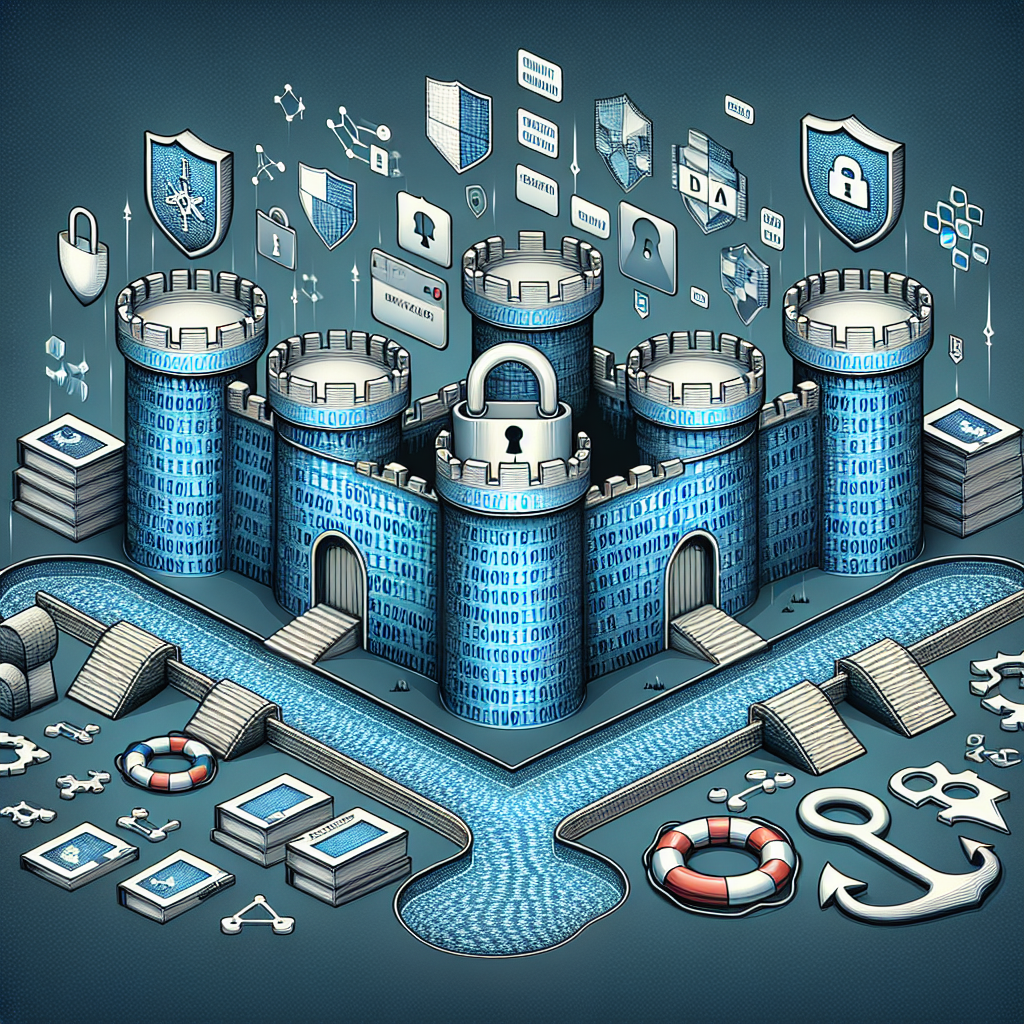Your cart is currently empty!
Tag: IT Outsourcing

Disaster Recovery Strategies: How to Ensure Business Continuity
In today’s fast-paced and ever-changing business environment, disaster recovery planning is essential to ensure business continuity. Disasters can strike at any time, whether they be natural disasters like hurricanes or earthquakes, or man-made disasters like cyber attacks or power outages. Without a solid disaster recovery strategy in place, businesses risk losing valuable data, revenue, and even their reputation.To ensure business continuity in the face of disaster, businesses must have a comprehensive disaster recovery plan in place. This plan should outline how the organization will respond to and recover from various types of disasters, and should be regularly tested and updated to ensure its effectiveness.
One key aspect of a disaster recovery strategy is data backup and recovery. Businesses should regularly back up their data to secure, off-site locations to ensure that critical information can be recovered in the event of a disaster. Cloud-based backup solutions are often recommended, as they provide secure, scalable storage options that can be accessed from anywhere.
Another important component of disaster recovery planning is identifying and prioritizing critical business functions. By assessing which functions are essential to the organization’s operations, businesses can develop strategies to ensure that these functions can be quickly restored in the event of a disaster. This may involve setting up redundant systems, training staff on emergency procedures, or establishing communication channels with key stakeholders.
Communication is also key to a successful disaster recovery strategy. Businesses should have clear communication plans in place to keep employees, customers, and suppliers informed about the organization’s response to a disaster. This may involve setting up emergency communication systems, such as mass notification tools or social media channels, to quickly disseminate information in a crisis.
Regular testing and training are crucial to ensuring that a disaster recovery plan is effective. Businesses should conduct regular drills and simulations to test their response to various disaster scenarios, and should update their plan based on lessons learned from these exercises. Staff should also be trained on emergency procedures and should be familiar with their roles and responsibilities in the event of a disaster.
In conclusion, disaster recovery planning is essential to ensure business continuity in the face of unforeseen disasters. By developing a comprehensive disaster recovery strategy that includes data backup and recovery, identifying critical business functions, establishing communication plans, and conducting regular testing and training, businesses can minimize the impact of disasters and protect their operations, revenue, and reputation. It is never too late to start planning for disaster recovery, so businesses should take action now to protect themselves and ensure their long-term success.

Ensuring Data Security: A Guide to Effective Backup and Recovery Strategies
In today’s digital age, data security is more important than ever. With the increasing threat of cyber attacks and data breaches, it is crucial for businesses to have effective backup and recovery strategies in place to protect their sensitive information.Ensuring data security involves not only preventing unauthorized access to data, but also ensuring that data is backed up and recoverable in the event of a disaster or system failure. Without proper backup and recovery strategies, businesses risk losing valuable information and facing costly downtime.
One of the most important steps in ensuring data security is to regularly back up data. This means making copies of important files and storing them in a secure location, such as an offsite data center or cloud storage service. By regularly backing up data, businesses can ensure that they have a copy of their information in case of a disaster or cyber attack.
In addition to regular backups, businesses should also consider implementing a disaster recovery plan. This plan outlines the steps that need to be taken in the event of a data breach or system failure, including how to restore data and get systems back up and running as quickly as possible. By having a disaster recovery plan in place, businesses can minimize the impact of a data breach or system failure and ensure that they can recover quickly.
Another important aspect of data security is encryption. Encryption involves encoding data so that it is unreadable to unauthorized users. By encrypting sensitive information, businesses can protect their data from cyber attacks and ensure that it remains secure even if it is stolen.
Furthermore, businesses should also consider implementing access controls to restrict who has access to sensitive data. By limiting access to sensitive information to only authorized users, businesses can reduce the risk of data breaches and ensure that their information remains secure.
Overall, ensuring data security requires a combination of preventative measures, such as encryption and access controls, as well as effective backup and recovery strategies. By implementing these strategies, businesses can protect their sensitive information and minimize the risk of data breaches and system failures. Ultimately, investing in data security is crucial for the long-term success and security of any business.

Remote Monitoring: A Game-Changer for Businesses in the Digital Age
In today’s fast-paced and technology-driven world, businesses are constantly looking for ways to streamline their operations and improve efficiency. One tool that has revolutionized the way businesses operate is remote monitoring.Remote monitoring allows businesses to keep a close eye on their operations and assets, even when they are not physically present. This technology uses sensors, cameras, and other devices to collect data and transmit it to a centralized system, where it can be analyzed and acted upon in real-time.
One of the biggest advantages of remote monitoring is that it allows businesses to proactively address issues before they escalate into major problems. For example, a manufacturing plant can use remote monitoring to track the performance of its machinery and detect any abnormalities that could indicate a potential breakdown. By addressing these issues early on, businesses can minimize downtime and costly repairs.
Remote monitoring is also a game-changer for businesses with multiple locations or a large fleet of vehicles. With remote monitoring, businesses can track the location and performance of their assets in real-time, allowing them to optimize routes, improve efficiency, and ensure the safety of their employees.
Another key benefit of remote monitoring is its ability to provide businesses with valuable insights and data that can be used to make informed decisions. By analyzing the data collected through remote monitoring, businesses can identify trends, patterns, and areas for improvement, allowing them to optimize their operations and drive growth.
In addition to improving operational efficiency, remote monitoring can also enhance the security of businesses. By installing cameras and sensors in key areas, businesses can monitor for unauthorized access, theft, and other security threats, helping to protect their assets and employees.
Overall, remote monitoring is a game-changer for businesses in the digital age. By providing real-time insights, improving operational efficiency, enhancing security, and enabling data-driven decision-making, remote monitoring is helping businesses stay ahead of the competition and drive success in today’s fast-paced and technology-driven world.

The Importance of Technical Support in Today’s Digital World
In today’s digital world, technology plays a crucial role in our everyday lives. From smartphones to laptops to smart home devices, we rely on technology to stay connected, be productive, and access information. However, with the increasing complexity of technology, problems and issues can arise that require technical support.Technical support is essential in today’s digital world for several reasons. First and foremost, it helps individuals and businesses troubleshoot and resolve issues with their devices and software. Whether it’s a malfunctioning smartphone, a virus-infected computer, or a network connectivity problem, technical support professionals are trained to diagnose and fix these issues quickly and efficiently.
Furthermore, technical support ensures that technology is used to its full potential. Many people are not aware of all the features and capabilities of their devices and software. Technical support can provide guidance and assistance on how to maximize the use of technology to improve efficiency, productivity, and overall user experience.
In addition, technical support plays a vital role in cybersecurity. With the increasing number of cyber threats and attacks, it is crucial to have proper security measures in place to protect sensitive data and information. Technical support professionals can help individuals and businesses set up firewalls, antivirus software, and other security measures to safeguard against cyber threats.
Moreover, technical support provides peace of mind for users. Knowing that there is a reliable and knowledgeable team of experts available to assist with any technical issue can alleviate stress and frustration when problems arise. This can ultimately lead to increased productivity and efficiency in both personal and professional settings.
Overall, the importance of technical support in today’s digital world cannot be overstated. As technology continues to advance and evolve, the need for reliable and efficient technical support services will only continue to grow. By investing in technical support, individuals and businesses can ensure that they are able to fully leverage the benefits of technology while also safeguarding against potential risks and threats.

10 Tips for Improving Help Desk Customer Service
Providing excellent customer service is crucial for any business, especially for a help desk support team. Help desk customer service plays a key role in retaining customers, resolving issues efficiently, and building a positive reputation for the company. Here are 10 tips for improving help desk customer service:1. Train your staff: Ensure that your help desk team is well-trained in customer service skills, technical knowledge, and problem-solving techniques. Regular training sessions can help employees stay up-to-date with the latest tools and technologies.
2. Use a ticketing system: Implement a ticketing system to track customer issues, prioritize them, and ensure timely resolution. This helps in managing customer queries effectively and providing a seamless experience.
3. Offer multi-channel support: Provide customers with various support channels such as phone, email, live chat, and self-service portals. This allows customers to choose the most convenient method for contacting support.
4. Set clear expectations: Communicate realistic timelines for issue resolution and keep customers informed about the progress of their requests. Setting clear expectations helps manage customer’s expectations and avoids misunderstandings.
5. Personalize interactions: Address customers by their name and personalize interactions to make them feel valued. Building a rapport with customers can enhance their overall experience and increase satisfaction.
6. Empower employees: Encourage your help desk team to make decisions and take ownership of customer issues. Empowered employees are more likely to provide proactive solutions and resolve problems efficiently.
7. Listen actively: Practice active listening skills by paying attention to customer concerns, asking clarifying questions, and empathizing with their situation. Listening attentively can help in understanding customer needs and building trust.
8. Provide timely responses: Respond to customer queries promptly, even if you don’t have an immediate solution. Acknowledge their concerns and assure them that you are working on resolving the issue.
9. Seek feedback: Encourage customers to provide feedback on their support experience and use it to identify areas for improvement. Feedback helps in understanding customer satisfaction levels and making necessary changes to enhance service quality.
10. Follow up: After resolving a customer issue, follow up with them to ensure that the problem has been resolved satisfactorily. This shows customers that you care about their experience and helps in building long-term relationships.
By implementing these 10 tips, help desk teams can improve customer service, boost customer satisfaction, and create a positive reputation for the company. Ultimately, providing exceptional help desk customer service contributes to customer loyalty and business success.

How to Optimize Your Network Management Strategy
In today’s digital age, network management has become a critical component for businesses to ensure seamless connectivity and productivity. With the increasing reliance on technology for day-to-day operations, having an effective network management strategy is essential for organizations of all sizes. By optimizing your network management strategy, you can improve performance, security, and reliability, ultimately leading to better business outcomes.Here are some key strategies to help you optimize your network management:
1. Conduct a Network Assessment: Before implementing any changes to your network management strategy, it’s important to conduct a thorough assessment of your current network infrastructure. This includes evaluating the performance of your network, identifying potential bottlenecks, and assessing security vulnerabilities. By understanding the current state of your network, you can better determine areas for improvement and develop a targeted optimization plan.
2. Implement Network Monitoring Tools: Network monitoring tools are essential for proactively identifying and addressing issues before they impact your business operations. These tools provide real-time visibility into your network performance, allowing you to monitor bandwidth utilization, track network traffic, and detect anomalies that may indicate potential problems. By investing in robust network monitoring tools, you can ensure that your network is running smoothly and efficiently.
3. Prioritize Security: In today’s cybersecurity landscape, network security is a top priority for businesses. Implementing strong security measures, such as firewalls, intrusion detection systems, and encryption protocols, can help protect your network from cyber threats and unauthorized access. Regularly updating your security policies and conducting security audits can further strengthen your network defenses and minimize the risk of data breaches.
4. Optimize Network Performance: To maximize the performance of your network, it’s important to optimize network configurations and settings. This includes fine-tuning network devices, such as routers and switches, to ensure optimal performance and minimize latency. Additionally, implementing Quality of Service (QoS) policies can help prioritize network traffic and ensure that critical applications receive the necessary bandwidth for smooth operation.
5. Embrace Automation: Automation can streamline network management processes and reduce the burden on IT teams. By automating routine tasks, such as configuration management, device provisioning, and troubleshooting, you can increase efficiency and free up resources to focus on strategic initiatives. Leveraging automation tools and technologies can help you optimize network management and improve overall operational efficiency.
By implementing these strategies, you can optimize your network management strategy and enhance the performance, security, and reliability of your network infrastructure. With a well-optimized network management strategy in place, your organization can better adapt to evolving technology trends and drive business growth in today’s digital landscape.

Top Cybersecurity Threats and How to Protect Yourself
In today’s digital age, cybersecurity threats are becoming more prevalent and sophisticated. With the increase in online activity, it is crucial to be aware of the top cybersecurity threats and how to protect yourself from falling victim to them.1. Phishing Attacks
Phishing attacks are one of the most common cybersecurity threats and involve cybercriminals posing as legitimate entities to steal sensitive information such as login credentials, credit card numbers, and personal data. These attacks often come in the form of emails or messages that appear to be from trusted sources. To protect yourself from phishing attacks, be cautious of any unsolicited emails or messages that ask for personal information. Verify the sender’s identity and never click on suspicious links or download attachments from unknown sources.
2. Ransomware
Ransomware is a type of malware that encrypts a victim’s files and demands payment in exchange for the decryption key. This type of cybersecurity threat can cause significant financial and reputational damage to individuals and businesses. To protect yourself from ransomware attacks, regularly back up your data, keep your software up to date, and be cautious when opening email attachments or clicking on links.
3. Malware
Malware, short for malicious software, is a broad category of cybersecurity threats that includes viruses, worms, Trojans, and spyware. Malware can infect your device and steal sensitive information, disrupt operations, or cause damage to your system. To protect yourself from malware attacks, install reputable antivirus software, keep your system updated, and avoid downloading software or files from unreliable sources.
4. Social Engineering
Social engineering is a tactic used by cybercriminals to manipulate individuals into divulging confidential information or performing actions that compromise security. This can include impersonating a trusted contact, using psychological manipulation, or exploiting human emotions to gain access to sensitive data. To protect yourself from social engineering attacks, be cautious of unsolicited requests for information, verify the identity of individuals requesting sensitive data, and educate yourself on common social engineering tactics.
5. DDoS Attacks
Distributed Denial of Service (DDoS) attacks involve overwhelming a website or online service with a high volume of traffic, causing it to become inaccessible to legitimate users. DDoS attacks can disrupt business operations, lead to financial losses, and damage a company’s reputation. To protect yourself from DDoS attacks, implement robust security measures such as firewalls, intrusion detection systems, and content delivery networks.
In conclusion, cybersecurity threats are a growing concern in today’s digital landscape. By understanding the top cybersecurity threats and implementing proactive security measures, you can protect yourself from falling victim to cybercriminals. Stay vigilant, keep your software updated, and educate yourself on best practices for online security to safeguard your personal information and digital assets.

Navigating the Cloud: A Beginner’s Guide to Cloud Computing
Cloud computing has become an integral part of our daily lives, with many people relying on it for storing data, accessing applications, and collaborating with others. However, for beginners, navigating the cloud can seem like a daunting task. In this beginner’s guide to cloud computing, we will break down the basics of cloud computing and provide tips on how to make the most of this powerful technology.What is Cloud Computing?
Cloud computing is the delivery of computing services over the internet, allowing users to access applications, store data, and collaborate with others without the need for physical hardware or infrastructure. Instead of storing data on a local computer or server, users can store their data on remote servers maintained by a cloud service provider.
Benefits of Cloud Computing
There are several benefits to using cloud computing, including:
1. Flexibility: Cloud computing allows users to access applications and data from anywhere with an internet connection, making it easy to work remotely or collaborate with others.
2. Scalability: Cloud computing services can easily scale up or down based on the needs of the user, making it ideal for businesses with fluctuating workloads.
3. Cost-effective: Cloud computing eliminates the need for expensive hardware and infrastructure, making it a cost-effective solution for businesses of all sizes.
4. Security: Cloud service providers invest in robust security measures to protect data from cyber threats, ensuring that data is safe and secure.
Navigating the Cloud: Tips for Beginners
1. Choose the Right Cloud Service Provider: When selecting a cloud service provider, consider factors such as pricing, scalability, security, and customer support. Popular cloud service providers include Amazon Web Services (AWS), Microsoft Azure, and Google Cloud Platform.
2. Understand the Different Types of Cloud Services: Cloud computing services are typically categorized into three types: Infrastructure as a Service (IaaS), Platform as a Service (PaaS), and Software as a Service (SaaS). Understand the differences between these services to determine which best suits your needs.
3. Backup Your Data: While cloud computing offers secure storage options, it is essential to regularly back up your data to ensure that it is protected in the event of a cyber attack or system failure.
4. Stay Up-to-Date on Security Best Practices: Cloud computing security is a shared responsibility between the user and the cloud service provider. Stay informed about security best practices and implement measures to protect your data from cyber threats.
5. Utilize Cloud-Based Applications: Take advantage of cloud-based applications such as Google Drive, Dropbox, and Microsoft Office 365 to increase productivity and collaboration with others.
In conclusion, cloud computing is a powerful technology that offers numerous benefits for individuals and businesses. By understanding the basics of cloud computing and following these tips for beginners, you can navigate the cloud with confidence and make the most of this innovative technology.

Maximizing Efficiency: The Benefits of IT Solutions
In today’s fast-paced business world, efficiency is key. Companies are constantly looking for ways to streamline operations, cut costs, and increase productivity. One of the most effective ways to achieve these goals is through the use of IT solutions.IT solutions encompass a wide range of technologies and services that help businesses optimize their processes and workflows. From cloud computing and data analytics to cybersecurity and digital transformation, IT solutions offer a wealth of benefits that can help companies operate more efficiently.
One of the primary benefits of IT solutions is improved productivity. By automating repetitive tasks, streamlining workflows, and providing real-time access to data and information, IT solutions can help employees work more efficiently and effectively. This not only saves time and reduces errors, but also allows employees to focus on more strategic tasks that drive business growth.
IT solutions also help companies cut costs. By centralizing data and applications in the cloud, businesses can reduce the need for expensive hardware and software investments. Additionally, IT solutions can help companies identify and eliminate inefficiencies in their processes, leading to cost savings over time.
Another key benefit of IT solutions is enhanced security. With the increasing number of cyber threats facing businesses today, it’s more important than ever to have robust cybersecurity measures in place. IT solutions can help companies protect their data, networks, and devices from malicious attacks, ensuring the safety and security of their sensitive information.
Furthermore, IT solutions can enable companies to stay competitive in today’s digital economy. By embracing technologies like artificial intelligence, machine learning, and Internet of Things, businesses can gain a competitive edge by offering innovative products and services that meet the changing needs of their customers.
Overall, IT solutions offer a wide range of benefits that can help businesses maximize their efficiency and drive growth. By leveraging the power of technology, companies can streamline operations, cut costs, improve productivity, enhance security, and stay ahead of the competition. It’s clear that investing in IT solutions is a smart move for any business looking to thrive in today’s digital world.

Top IT Outsourcing Trends to Watch in 2021
The IT outsourcing industry has been growing rapidly in recent years, and 2021 promises to be no different. As companies continue to look for ways to cut costs and improve efficiency, outsourcing IT services has become an increasingly popular option. Here are some of the top IT outsourcing trends to watch in 2021.1. Cloud computing: Cloud computing has been a game-changer for the IT outsourcing industry, allowing companies to access resources and data from anywhere in the world. In 2021, we can expect to see even more companies outsourcing their IT infrastructure to the cloud, as it offers cost savings, scalability, and flexibility.
2. Cybersecurity: With the rise of cyber threats and data breaches, cybersecurity has become a top priority for companies of all sizes. As a result, many companies are turning to IT outsourcing providers to help them strengthen their security measures and protect their sensitive data. In 2021, we can expect to see a growing demand for cybersecurity services from outsourcing providers.
3. Artificial intelligence and automation: Artificial intelligence and automation are transforming the way companies do business, and IT outsourcing is no exception. In 2021, we can expect to see more outsourcing providers incorporating AI and automation technologies into their services to help clients improve efficiency and streamline their operations.
4. Remote work: The COVID-19 pandemic has accelerated the shift towards remote work, and IT outsourcing providers have had to adapt to this new reality. In 2021, we can expect to see more outsourcing providers offering remote IT services to help companies navigate the challenges of managing a remote workforce.
5. Data analytics: Data analytics has become a key driver of business success, and companies are increasingly turning to IT outsourcing providers to help them make sense of their data. In 2021, we can expect to see more outsourcing providers offering data analytics services to help companies gain valuable insights and make informed decisions.
Overall, the IT outsourcing industry is poised for a successful year in 2021, as companies continue to look for ways to leverage technology to drive growth and innovation. By keeping an eye on these top trends, companies can stay ahead of the curve and make the most of their IT outsourcing partnerships.
